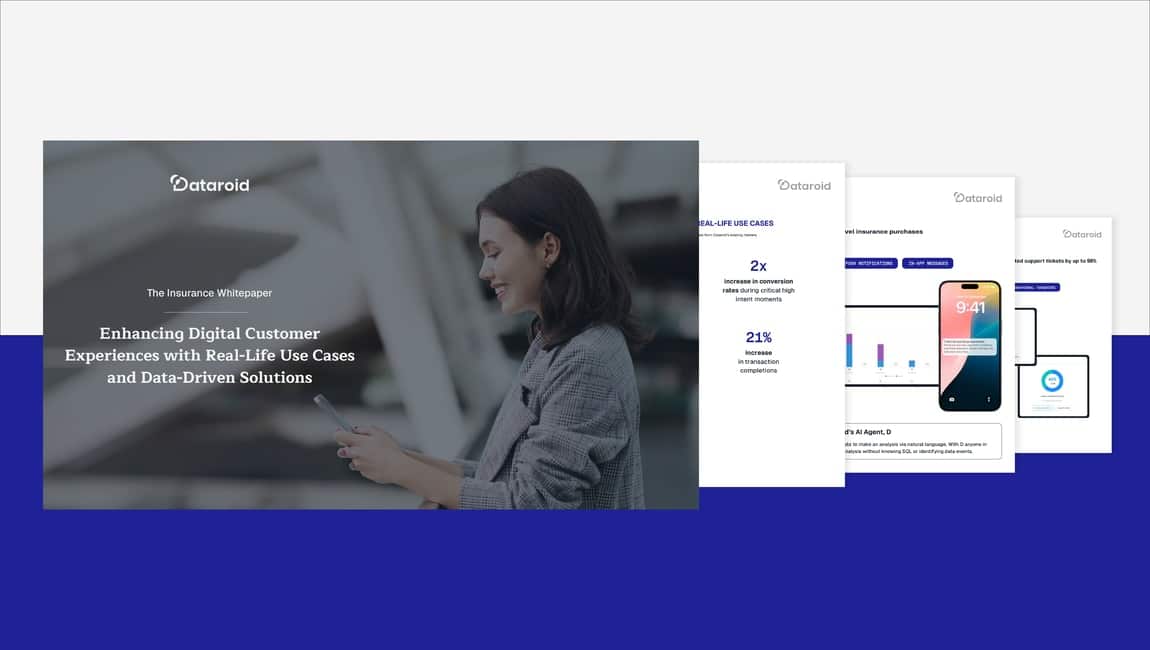What is Customer Segmentation and How to Use It Effectively
- Reading Time: 12 minutes
Learn effective customer segmentation to boost your marketing success. Tailor strategies to resonate with your audience and stay ahead of market trends.
What is customer segmentation?
Customer segmentation is a strategy that divides customers into distinct groups based on shared characteristics and behavioral patterns. It helps businesses understand their customer base, tailor marketing strategies, and gain insights into customer behavior and preferences. Real-time data analysis enables effective segmentation and data-driven insights.

The importance of segmenting customers
Segmenting customers is crucial for enhancing marketing, sales, strategy and customer experience efforts. By dividing customers into distinct groups based on shared characteristics, businesses can personalize the customer experience and target specific customer segments effectively. This not only increases customer loyalty and retention but also provides valuable insights into customer behavior. With customer segmentation analysis, companies can leverage available data and employ different methodologies to identify new customer segments. Implementing a customer segmentation strategy is a good idea for marketers, product and customer experience teams, as it helps them tailor their approach to different groups of existing and potential customers.
Sign up to drive your business with the power of data
Benefits of customer segmentation
Segmentation analysis enables businesses to identify new segments and understand the existing customer segment base better and develop products, making changes to the existing product, presenting it to the relevant audience and personalizing it for another target audience that cater to the specific needs of those segments. This leads to improved customer satisfaction and engagement, as customers feel understood and valued.
Additionally, customer segmentation allows for more effective marketing strategies, as businesses can target their messaging and promotions to different and accurate groups based on their preferences and behaviors. By optimizing their resources through customer segmentation, businesses can allocate their time, money, and efforts in the most effective way. This helps them maximize their return on investment and ultimately achieve their business goals. Customer segmentation is a valuable strategy for businesses looking to enhance their customer service, attract potential customers, and stay competitive in the market.
In digital transformation era
In the age of digital transformation, digital segmentation is crucial to understand online customer behavior. By analyzing digital interactions, businesses gain insight into preferences and needs. This enables personalized marketing campaigns, optimizing the customer journey with timely and relevant content. Real-time data improves targeting, resulting in higher engagement and satisfaction. Businesses tailor their strategies to specific segments through customer segmentation analysis, maximizing companies’ efforts in this era of digital evolution.
In ROI increasing points
Segmenting customers by revenue and incorporating RFM (Recency, Frequency, Monetary) analysis is a vital strategy for businesses to pinpoint high-value customers. This dual approach helps prioritize marketing and sales efforts towards specific segments that not only generate the most revenue but also have a recent and frequent interaction history. RFM analysis uncovers opportunities for upselling and cross-selling, boosting overall profitability. Effective revenue based and RFM segmentation optimizes resource allocation, ensuring businesses target the right customers with the right offers and maximize revenue potential, leading to sustainable growth.
Strategically
Strategic segmentation is a valuable approach in marketing that helps align efforts with business goals. It involves identifying and targeting specific customer groups, allowing for tailored marketing strategies. This approach improves customer targeting, acquisition, and resource allocation. By utilizing data and techniques like customer segmentation analysis, businesses can create an effective customer segmentation strategy. Additionally, tools like artificial intelligence or modeling and predictions can help identify new customer segments and potential buyers, leading to increased revenue and expanded reach.
Types of customer segmentation
Different types of segmentation provide unique insights into customer behavior and preferences, allowing businesses to target their marketing efforts more effectively. Combining multiple segmentation types, such as demographic and digital segmentation, enhances the understanding of customer needs and preferences. By utilizing a comprehensive customer segmentation strategy, businesses can identify potential customers, develop targeted and insightful marketing campaigns, and introduce new products to different customer groups.
Digital segmentation
Digital segmentation is like a marketing superpower, breaking down online customer behavior into manageable chunks for businesses. It involves analyzing website visits, social media engagement, and email interactions to understand and connect with the audience on a personalized level. This data-driven approach helps craft tailored digital marketing strategies, like having a conversation with each customer based on their online habits. The real magic lies in uncovering new customer segments, turning digital data into a treasure trove of opportunities. In the fast-paced world of digital marketing, digital segmentation is the compass that guides businesses through the ever-changing landscape, building relationships one personalized interaction at a time.
Demographic segmentation
Demographic segmentation is a marketing strategy that categorizes customers based on traits like age, gender, marital status, and income. This segmentation helps businesses target specific customer groups and understand consumer behavior. It involves analyzing demographic data from various sources, such as job titles or social media profiles, to create buyer personas and tailored marketing strategies. Incorporating demographic segmentation into a business plan can enhance targeting, personalization, and customer satisfaction, leading to increased loyalty.
Psychographic segmentation
Psychographic segmentation is about understanding customer behavior, preferences, values, and lifestyles to tailor marketing messages based on psychological factors. This enables personalized communication that resonates with specific customer segments. Marketers use data from sources like social media, customer interactions, and online behavior, combined with AI and advanced methods, to identify and target distinct psychographic segments. This approach provides valuable insights for creating highly tailored marketing campaigns.
Geographic segmentation
Geographic segmentation involves dividing customers by location to customize marketing strategies for specific regions, using local language and culture for better connections. Analyzing regional trends helps businesses adapt marketing. It’s a valuable strategy to reach potential customers effectively, tailoring messaging and offers to specific areas for better results. Implementing geographic segmentation enhances marketing and customer service, maximizing efforts.
Technographic segmentation
Segmenting customers based on their technology preferences helps businesses tailor products and messaging, leading to more engagement and conversions. Staying current with tech trends allows businesses to refine their strategies. Technographic segmentation provides insights into customer tech behavior, optimizing marketing for better outcomes.
Needs-based segmentation
Identifying and grouping customers based on their unique product needs is vital for effective needs-based segmentation. This approach enables tailored marketing strategies, addressing specific requirements, enhancing customer engagement and satisfaction. Regularly updating segments to align with evolving customer needs is crucial for maintaining relevance and effectiveness. Marketers can use customer segmentation analysis and data analysis to create a robust segmentation strategy, leading to improved customer understanding and service optimization, ultimately driving success.
Value-based segmentation
Segmenting customers based on perceived product or service value is a crucial strategy for businesses. It helps identify high-value customers for personalized engagement and optimized revenue. Loyalty building among high-value segments boosts long-term profitability. Regularly adjusting segments based on customer feedback is essential. Implementing this strategy requires data utilization and marketing expertise. Leveraging analytics tools and AI provides insights for targeted marketing campaigns.
Importance of real-time data collection for segmentation
Gathering data on customer behavior and preferences in real time is crucial for effective customer segmentation. By doing so, businesses can respond quickly to changing customer needs and demands, allowing them to stay ahead of the competition. Real-time data collection also enables companies to improve targeting and personalization by gaining immediate insights into customer preferences and behaviors. With these insights, businesses can enhance the customer experience through timely and relevant communication. Additionally, real-time data collection allows marketers to optimize their marketing campaigns based on up-to-date customer data, ensuring that their efforts are focused on the most effective way to reach existing and potential customers. By leveraging real-time data, businesses can effectively implement a customer segmentation strategy and drive better results.
Implementing customer segmentation
To successfully implement customer segmentation, it is important to define clear objectives for the segmentation process. This will help guide the entire process and ensure that the segmentation aligns with your business goals. Once the objectives are defined, gather relevant data from various sources to inform your segmentation strategy. This can include customer demographics, digital behavior, and preferences. With the data in hand, analyze and segment customers based on defined criteria such as age, location, or buying habits. This will help you divide your customer base into distinct groups with similar characteristics. Develop targeted marketing strategies for each segment to effectively engage with your customers. Regularly evaluate and refine your segmentation approach to ensure it remains effective in meeting your business objectives.
Common mistakes to avoid in customer segmentation
When implementing a customer segmentation strategy, it’s important to avoid common mistakes that can hinder its effectiveness. One common mistake is relying solely on demographic information for segmentation. While demographics provide valuable insights, behavioral segmentation allows you to understand and target potential customers based on their actions and preferences. Neglecting to update segments based on changing customer behavior is another mistake to avoid. As customer needs evolve, it’s crucial to regularly review and adjust your segments accordingly. Additionally, overlooking the importance of qualitative data in understanding customer motivations can compromise the accuracy of your segmentation. To ensure alignment with overall business goals, it’s essential to develop a clear strategy and methodology for segmentation. Finally, testing and validating your segmentation models before implementation is a critical step in ensuring their accuracy and effectiveness. By avoiding these common mistakes, you can improve the success of your customer segmentation efforts.
Practical tips for implementing segmentation strategies
To effectively implement segmentation strategies, it is crucial to start with a clear understanding of your target audience. By identifying key data points for segmentation, you can gather relevant information to categorize your customers into different groups. It’s essential to use a combination of both quantitative and qualitative research methods to gain deeper insights into customer behavior and preferences.
Continuously refining your segmentation approach based on feedback and results is another important aspect of successful implementation. This includes regularly evaluating the effectiveness of your segmentation strategy and making necessary adjustments. Additionally, involving key stakeholders from different departments in the segmentation process ensures that you have a holistic perspective on your customers and their needs.
By following these practical tips, you can create effective customer segmentation strategies that drive marketing and business outcomes. Utilizing the available data and employing various research methodologies enables marketers to target potential customers more accurately. It is a good idea to refine segments continuously based on feedback and results in order to optimize their effectiveness and enhance the overall customer experience. Involving key stakeholders from different departments further enhances the segmentation process by incorporating diverse perspectives and expertise.
Make segments easy to use
To ensure effective customer segmentation, simplification is key. This involves employing clear and straightforward segmentation categories, offering user-friendly data analysis tools, providing training for team members in using segmentation insights effectively, and maintaining regular communication with stakeholders regarding segment updates. These strategies streamline the segmentation process, enhancing its usability and ultimately contributing to business growth and success.
Make customer segments the right size
To create effective customer segments, focus on digital behavior and real-time data for dynamic adaptability. Craft specific and actionable segments for tailored marketing. Adapt based on customer feedback for ongoing improvements, optimizing your strategy to reach potential customers effectively.
Make them easy to access
To optimize customer segmentation, it’s vital to provide user-friendly interfaces for easy access and analysis. Automation should be used to create and update segments, reducing manual work and improving accuracy. Ensure they are understandable for all stakeholders, regardless of technical expertise. Centralized platforms enhance segmentation efficiency, maximizing its value and meeting diverse customer needs.
Create stable & dynamic segments
To create stable customer segments, use both demographic and psychographic data. This combination helps understand customer characteristics and preferences. Machine learning can identify evolving patterns. Regularly update segments. Consider customer lifecycle stages for tailored segments. Continuously incorporate customer feedback for refinement.
Understand how different models overlap
Analyzing the synergy of different customer segmentation models is vital for optimizing marketing efforts. By identifying overlapping segments, resources can be allocated efficiently. Analytics are key to measuring segment performance across models, and AI aids in uncovering correlations between segments for targeted campaigns. This integrated approach, along with behavioral segmentation and data utilization, helps create a strong, goal-aligned customer segmentation strategy.
Find your loyal customers
To find and retain loyal customers, businesses can employ various strategies. Segmentation analysis helps identify highly engaged and loyal customers within the customer base. Customer loyalty programs can be implemented to encourage ongoing loyalty. Analyzing customer behavior reveals loyalty patterns for targeted marketing. Personalization is crucial in creating personalized experiences based on customer preferences and needs. Implementing these strategies can help cultivate a loyal customer base, contributing to business success.
Customer segmentation analysis
Analyzing customer data is a crucial step in understanding your target audience. Customer segmentation analysis helps identify distinct segments by leveraging available data such as demographics, geography, and psychographics. By using this analysis, you can gain valuable insights into customer behavior and preferences. It allows you to identify key characteristics and commonalities within segments, enabling you to tailor your marketing strategies accordingly. The analysis also provides a deeper understanding of your existing and potential customers, helping you to target them effectively. By segmenting your customers, you can create personalized experiences and engage with different groups based on their specific needs and interests. This way, you can optimize your marketing efforts and ensure your messages resonate with the right audience. Leveraging customer segmentation analysis is a valuable strategy for marketers looking to unlock the full potential of their customer base and drive business growth.
Customer segmentation tools and software
To effectively implement customer segmentation, it is crucial to utilize various tools and software. CRM and marketing automation software can be utilized to gather customer data and automate segmentation processes. These tools enable businesses to identify and target specific segments based on customer behavior and preferences. Additionally, implementing data collection methods helps gather valuable customer behavior data, which can be used for behavioral segmentation. Leveraging customer support and feedback tools enhances segmentation by providing insights into customer needs and preferences. Furthermore, artificial intelligence (AI) and machine learning algorithms can be employed for advanced segmentation, allowing businesses to analyze large datasets and identify new customer segments. By utilizing these tools and software, businesses can enhance their customer segmentation strategies and effectively target potential customers.
Future trends in customer segmentation
Embracing emerging technologies like artificial intelligence (AI) and machine learning is becoming increasingly important in the field of customer segmentation. These technologies have the potential to revolutionize the way businesses understand and target their customers. By incorporating social media and digital data, businesses can gain valuable insights into customer behavior and preferences, leading to enhanced segmentation strategies. Additionally, utilizing customer feedback and sentiment analysis can provide further insights, allowing for more personalized and effective segmentation. Exploring innovative ways to collect customer data, such as through tools like Dataroid, can also provide a wealth of information for segmentation purposes. Ultimately, the future of customer segmentation lies in leveraging advanced technologies and data analysis techniques to create tailored messaging and experiences for different customer groups.
Frequently asked questions about customer segmentation
How can I collect real-time digital behavioral data for effective customer segmentation?
Use product analytics and customer engagement tools like Dataroid to collect real-time digital behavioral data for effective customer segmentation. This tool gives you the ability to analyze interactions with users and monitor them.
What is the purpose of customer segmentation?
Customer segmentation serves the purpose of dividing a larger customer base into smaller groups with similar characteristics. This enables businesses to tailor their marketing efforts and messages to specific customer segments, identifying profitable opportunities and addressing the unique needs of different groups. Effective segmentation can lead to increased customer loyalty, retention, and profitability.
Are customer segmentation and market segmentation the same concept?
Customer segmentation and market segmentation are related but distinct concepts. While market segmentation divides a large market into smaller groups based on similarities, customer segmentation specifically focuses on dividing customers based on demographics, behaviors, or other factors. Both types of segmentation assist businesses in targeting specific groups with personalized marketing strategies.
What are the five Ws of customer segmentation?
Identifying the target audience (Who), understanding their needs and preferences (What), knowing their geographic location (Where), and considering the timing or seasonality of demand (When) are crucial aspects of customer segmentation. These five Ws help businesses gain valuable insights for effective targeting and personalized marketing strategies.
When should I use customer segmentation?
Customer segmentation should be used when businesses want to target specific groups of customers and tailor their marketing efforts to a particular audience. It helps improve customer satisfaction by providing targeted messaging and personalized experiences. Implement customer segmentation when you have sufficient data about your customers to make informed decisions.
Key Takeaways
Customer segmentation is a powerful tool that can help businesses understand their customers better and tailor their marketing strategies accordingly. By dividing customers into distinct segments based on their demographics, psychographics, geographic location, and more, businesses can create targeted campaigns that resonate with their target audience. Additionally, real-time data collection plays a crucial role in effective customer segmentation. With the help of advanced customer segmentation tools and software, businesses can analyze customer behavior, preferences, and purchase history to gain valuable insights. This enables them to make data-driven decisions and optimize their marketing efforts. As customer segmentation continues to evolve, it’s important for businesses to stay updated with the latest trends and technologies. Contact the Dataroid team to get more information on this subject. Together we can unlock the full potential of your business and maximize your conversion rates.
Drive your digital growth
Schedule a demo today to learn more on how we can help you unleash the potential of digital using Dataroid.




